Experiments with crystal filters. Encyclopedia of radio electronics and electrical engineering

Encyclopedia of radio electronics and electrical engineering / Knots of amateur radio equipment. Quartz filters
 Comments on the article
Comments on the article
I have made several types of crystal filters. All LSB type crystals are made in Japan. To evaluate and display the frequency response of a filter, I introduced the concepts of "sharpness factor" and "bandwidth". These are my personal definitions, which differ from professional terminology. See Fig.1
All filters are made on crystals with a frequency of 10.645MHz.
I have experienced the following 6 types of filters:
- Fig2 : 1 crystal : simple filter (suggested by W1FB)
- Fig3 : 2 crystals : basic circuit
- Fig4 : 4 crystals : basic circuit
- Fig5 : 4 crystals : with large capacitors
- Fig6 : 4 crystals : with even larger capacitors
- Fig7 : 4 crystals : with small capacitors
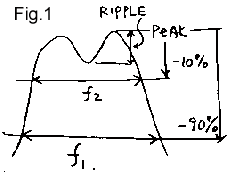 Fig1. shows definitions on this page.
Fig1. shows definitions on this page.
f1 = bandwidth.
|
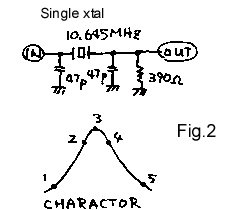 | Single-chip filter (fig.2)
| Point | Frequency | Voltage | Attenuation | | No. | MHz | V | dB | | 1 | 10.62337 | 0.06 | -20 | | 2 | 10.64392 | 0.54 | -0.9 | | 3 | 10.64510 | 0.6 | 0 | | 4 | 10.64641 | 0.54 | -0.9 | | 5 | 10.65474 | 0.06 | -20 |
| character
* 500 ohm impedance (minimum at the center of the passband)
* bandwidth f2=2.49kHz
* spicy factor 8%
* unevenness (ripple) - no
* this filter is good for AM receivers |
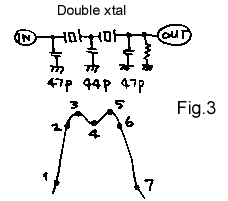 | Double crystal filter (fig.3)
| Point | Frequency | Voltage | Attenuation | | No. | MHz | V | dB | | 1 | 10.63578 | 0.055 | -20 | | 2 | 10.64400 | 0.5 | -0.9 | | 3 | 10.64488 | 0.55 | 0 | | 4 | 10.64592 | 0.53 | -0.3 | | 5 | 10.64628 | 0.54 | -0.1 | | 6 | 10.64696 | 0.5 | -0.9 | | 7 | 10.65083 | 0.055 | -20 |
| character
* 82 ohm impedance (min at the center of the passband)
* bandwidth f2=2.96kHz
* spicy factor 20%
* passband ripple 0.3dB
* this filter is good for simple SSB receivers. |
 | Three-crystal filter (fig.4)
| Point | Frequency | Voltage | Attenuation | | No. | MHz | V | dB | | 1 | 10.64309 | 0.05 | -20 | | 2 | 10.64441 | 0.45 | -0.9 | | 3 | 10.64484 | 0.5 | 0 | | 4 | 10.64564 | 0.43 | -0.13 | | 5 | 10.64650 | 0.5 | 0 | | 6 | 10.64693 | 0.45 | -0.9 | | 7 | 10.64786 | 0.05 | -20 |
| character
* 27 ohm impedance (min at the center of the passband)
* bandwidth f2=2.52kHz
* spicy factor 52%
* this filter is good for SSB receivers and transmitters. |
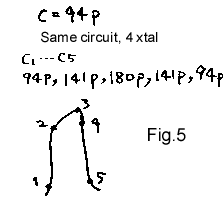 | Quadruple filter (fig.5)
with large capacitors
| Point | Frequency | Voltage | Attenuation | | No. | MHz | V | dB | | 1 | 10.64319 | 0.04 | -20 | | 2 | 10.64408 | 0.36 | -0.9 | | 3 | 10.64509 | 0.4 | 0 | | 4 | 10.64555 | 0.36 | -0.9 | | 5 | 10.64618 | 0.058 | -20 |
| character
* 21 ohm impedance (min at the center of the passband)
* bandwidth f2=1.47kHz
* spicy factor 49%
* this filter is good for narrow band filters of SSB receivers. |
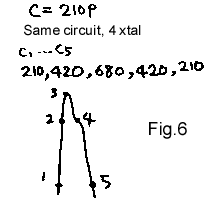 | Quadruple filter (fig.6)
with even larger capacitors
| Point | Frequency | Voltage | Attenuation | | No. | MHz | V | dB | | 1 | 10.64350 | 0.02 | -20 | | 2 | 10.64373 | 0.18 | -0.9 | | 3 | 10.64395 | 0.2 | 0 | | 4 | 10.64405 | 0.18 | -0.9 | | 5 | 10.64473 | 0.02 | -20 |
| character
* 40 ohm impedance (min at the center of the passband)
* bandwidth f2=0.32kHz=320Hz
* spicy factor 26%
* this filter is good for narrowband CW receivers. |
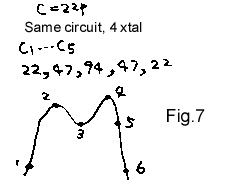 | Quadruple filter (fig.7)
with small capacitors
| Point | Frequency | Voltage | Attenuation | | No. | MHz | V | dB | | 1 | 10.64219 | 0.05 | -20 | | 2 | 10.64493 | 0.40 | -1.9 | | 3 | 10.64668 | 0.35 | -3.1 | | 4 | 10.64848 | 0.55 | 0 | | 5 | 10.64906 | 0.50 | -0.9 | | 6 | 10.65014 | 0.05 | -20 |
| character
* impedance 82ohm (min at the center of the bandwidth)
* bandwidth f2=4.13kHz
* pungency factor - 52%
* this filter is good for AM and narrowband FM receivers. |
My findings:
- A large number of crystals improves the shape of the filter's frequency response (increases squareness).
- Large capacitors make for a narrower bandwidth.
- The input impedance of this type of crystal filter is about 10 ohms.
- The impedance varies within the bandwidth.
- The minimum impedance is at the center of the passband.
Author: Kazuhiro Sunamura, JF1OZL, Japan, translated by Nikolai Bolshakov, RA3TOX; Publication: N. Bolshakov, rf.atnn.ru
 See other articles Section Knots of amateur radio equipment. Quartz filters.
See other articles Section Knots of amateur radio equipment. Quartz filters.
 Read and write useful comments on this article.
Read and write useful comments on this article.
<< Back
 Latest news of science and technology, new electronics:
Latest news of science and technology, new electronics:
Machine for thinning flowers in gardens
02.05.2024
In modern agriculture, technological progress is developing aimed at increasing the efficiency of plant care processes. The innovative Florix flower thinning machine was presented in Italy, designed to optimize the harvesting stage. This tool is equipped with mobile arms, allowing it to be easily adapted to the needs of the garden. The operator can adjust the speed of the thin wires by controlling them from the tractor cab using a joystick. This approach significantly increases the efficiency of the flower thinning process, providing the possibility of individual adjustment to the specific conditions of the garden, as well as the variety and type of fruit grown in it. After testing the Florix machine for two years on various types of fruit, the results were very encouraging. Farmers such as Filiberto Montanari, who has used a Florix machine for several years, have reported a significant reduction in the time and labor required to thin flowers.
... >>
Advanced Infrared Microscope
02.05.2024
Microscopes play an important role in scientific research, allowing scientists to delve into structures and processes invisible to the eye. However, various microscopy methods have their limitations, and among them was the limitation of resolution when using the infrared range. But the latest achievements of Japanese researchers from the University of Tokyo open up new prospects for studying the microworld. Scientists from the University of Tokyo have unveiled a new microscope that will revolutionize the capabilities of infrared microscopy. This advanced instrument allows you to see the internal structures of living bacteria with amazing clarity on the nanometer scale. Typically, mid-infrared microscopes are limited by low resolution, but the latest development from Japanese researchers overcomes these limitations. According to scientists, the developed microscope allows creating images with a resolution of up to 120 nanometers, which is 30 times higher than the resolution of traditional microscopes. ... >>
Air trap for insects
01.05.2024
Agriculture is one of the key sectors of the economy, and pest control is an integral part of this process. A team of scientists from the Indian Council of Agricultural Research-Central Potato Research Institute (ICAR-CPRI), Shimla, has come up with an innovative solution to this problem - a wind-powered insect air trap. This device addresses the shortcomings of traditional pest control methods by providing real-time insect population data. The trap is powered entirely by wind energy, making it an environmentally friendly solution that requires no power. Its unique design allows monitoring of both harmful and beneficial insects, providing a complete overview of the population in any agricultural area. “By assessing target pests at the right time, we can take necessary measures to control both pests and diseases,” says Kapil ... >>
 Random news from the Archive Random news from the Archive 1,5 exaflops supercomputer
13.05.2019
AMD is partnering with the US Department of Energy (DOE), Oak Ridge National Laboratory (ORNL), and Cray Inc. announced the creation of an exascale class supercomputer, which is expected to be the fastest in the world and will be operational at ORNL in 2021.
To deliver more than 1,5 exaflops of expected compute performance, Frontier will use high-performance computing (HPC) and AI-optimized custom AMD EPYC processors and dedicated Radeon Instinct GPUs. ORNL researchers will use the Frontier system's unparalleled processing power and next-generation artificial intelligence to simulate, model, and explore the interactions that underpin weather science, subatomic structure, genomics, physics, and other critical scientific fields.
AMD innovations in Project Frontier include custom AMD EPYC processors and next-generation dedicated Radeon Instinct GPUs, optimized for high-performance computing (HPC) and artificial intelligence, coupled with High-Bandwidth Memory (HBM) and the ability to work optimally with multiple data types at the same time, which is necessary in machine learning; Dedicated high-speed, low-latency Infinity Fabric interconnect for connecting four AMD Radeon Instinct GPUs to one AMD EPYC CPU per node; An enhanced version of the ROCm open programming environment, developed in collaboration with Cray, for sharing AMD CPUs and GPUs.
|
 Other interesting news:
Other interesting news:
▪ Why e-commerce won't replace brick-and-mortar
▪ Household DNA analysis and pollution level sensor
▪ radio controlled enzymes
▪ Unlock by vein pattern
▪ New ferroelectric memory chip FM25L16
 News feed of science and technology, new electronics
News feed of science and technology, new electronics
 Interesting materials of the Free Technical Library:
Interesting materials of the Free Technical Library:
▪ section of the site Security and safety. Article selection
▪ article Bring down the pantalyku. Popular expression
▪ article What is strange about the red-nosed deer Rudolph? Detailed answer
▪ article Damn bush. Legends, cultivation, methods of application
▪ article Daltometer for determining reaction time to light stimuli. Encyclopedia of radio electronics and electrical engineering
▪ article Transmitter for Forget-Me-Not. Encyclopedia of radio electronics and electrical engineering
 Leave your comment on this article:
Leave your comment on this article:
 All languages of this page
All languages of this page
Home page | Library | Articles | Website map | Site Reviews

www.diagram.com.ua
2000-2024








 Arabic
Arabic Bengali
Bengali Chinese
Chinese English
English French
French German
German Hebrew
Hebrew Hindi
Hindi Italian
Italian Japanese
Japanese Korean
Korean Malay
Malay Polish
Polish Portuguese
Portuguese Spanish
Spanish Turkish
Turkish Ukrainian
Ukrainian Vietnamese
Vietnamese






 Leave your comment on this article:
Leave your comment on this article: